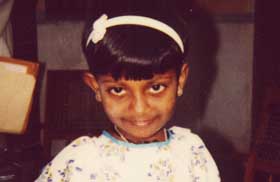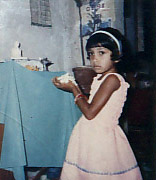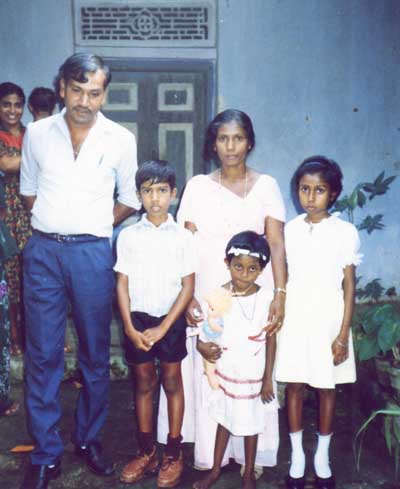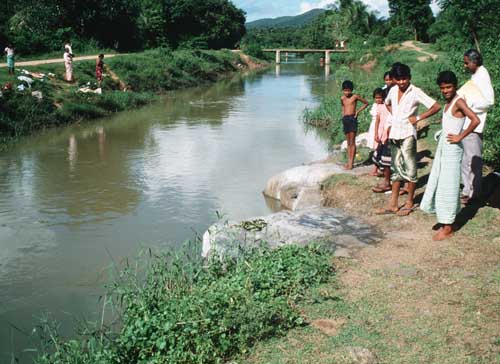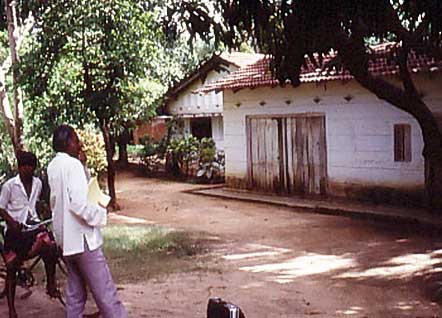This is one of a handful of reincarnation cases in which written records were made of a child’s statements about a previous life before an investigation was attempted. Before she was two years old, Dilukshi Nissanka began to speak about a life in a village about eighty miles distant from her home, which ended when she drowned in a stream. She refused to address her parents as mother and father and asked to be taken to her previous mother. Most of her 22 statements about the previous life were verified. A documentary made of this case by Storyhouse Productions in Washington DC was shown worldwide.
Development of the Case
Dilukshi was born in October 1984 in Veyangoda, Sri Lanka, and began to talk about a previous life at age two. Her parents tried in vain to get her to stop. When the girl was almost five years old, they gave up and asked the help of a relative, BA Sunil. He in turn contacted the Venerable Sumangala, an archaeologist and abbot of the Dambulla rock temple. Sumangala asked Sunil to write up a list of the statements that Dilukshi had been making, which he did from memory. With that list in hand, he made enquiries around Dambulla, but failed to find any deceased child that fit Dilukshi’s statements.
The abbot then contacted a journalist he knew, HW Abeypala, who interviewed Dilukshi’s parents and wrote an account in the Weekend newspaper; the item appeared on 10 September 1989. Dharmadasa Ranatunga in Dambulla read the report and recognized the statements as matching his deceased daughter Shiromi Inoka, who had drowned in a canal near their home in 1983 (almost exactly one year before Dilukshi was born). He wrote to Dilukshi’s father and mailed a photocopy of the letter to Sumangala.
The Ranatunga family lives in a village in the Dambulla subdistrict, some eighty miles from Dilukshi’s home in Veyangoda. Dilukshi’s parents had no friends, relatives or other connections with Dambulla. Only once had they visited the famous Dambulla rock temple, as they were on their way back from a pilgrimage to Anuradhapura.
A few days after Ranatunga contacted Dilkushi’s parents, they took her to Dambulla, together with the journalist Abeypala. Sumangala and Ranatunga joined them there. Dilukshi gave the party directions to Ranatunga’s house, some four miles from the town of Dambulla. There she recognized objects and persons to such a degree that the Ranatunga family accepted her as their former daughter.
Reincarnation researcher Erlendur Haraldsson learned about the case through an article in a Sri Lankan newspaper. He obtained the two documents that recorded Dilukshi’s statements before the previous personality was sought – Sunil’s letter to the abbot and Abeypala’s article in Weekend – and re-interviewed the key witnesses. There are 22 items in the Weekend report and thirteen items in Sunil’s letter. There are a few slight discrepancies between the lists, most likely due to the different circumstances in which the records were made.
Haraldsson published a report of his investigation in a journal paper and later in a book, I Saw a Light and Came Here, which he co-authored with James Matlock.1Haraldsson (1991); Haraldsson & Matlock (2016). Dilukshi Nissanka’s story was also the subject of a the documentary Past Lives: Stories of Reincarnation from Storyhouse Productions (Washington, DC).2The documentary was produced by Andreas Gutzeit. It was broadcast in the USA on The Learning Channel (Discovery Communications) on 1 April 2003, and on Discovery International on 29 December 2003.
Dilukshi’s Statements
Dilukshi’s statements, as published in the Weekend newspaper were as follows:
- My mother lives in Peravatte in Dambulla.
- My brother and I fell into the stream and I came here (was reborn).
- A stream with a footbridge over it skirts the paddy field near the house.
- Our house is near Heenkolla’s boutique.
- We used to buy provisions in Heenkolla’s shop.
- The roof of our house could be seen from the small Dambulla rock (punchi Dambulla gala).
- We played on the smaller rock. I played shopkeeper (mudalali) in the boutique. There was a little doll in our boutique.
- One day I climbed the Dambulla rock and my brother and I fell down.
- There is a public drinking cistern (pinthaliya) at Dambulla temple.
- I went to school by van.
- Father took me in the van to school.
- I have friends and we have been in Colombo.
- My father is owner of a metal quarry.
- Father is fair in complexion.
- Mother is very fair.
- Younger brother (malle) is very dark.
- I was known as Suwanna.
- My mother was named Swarna (I cannot remember my father’s name).
- My mother wears a housecoat with beautiful buttons.
- My brothers, Mahesh (elder) and Thushara (younger) are waiting for me in our play boutique.
- Two children fell into the stream while playing near the footbridge.
- My mother is not like you, aunt (present mother). She loves me very much.
Verifications
‘My mother lives in Perawatte in Dambulla.’ Sumangala learned that no village existed by the name of Perawatte, which literally means a gova fruit (pera) garden (watte). However, Mrs Ranatunga told Haraldsson that her daughter had sometimes called her home Perawatte because of the number of fruit trees growing there. Mr Ranatunga said there were a number of gova trees at a house close by. Also, a young relative named Wimala Amarakone, who lived with the family for two years and who was very close to Shiromi, said that Shiromi always insisted on going through the place she called Perawatte on the way home from school, when the gova trees were bearing fruit. She, and only she, had called this place Perawatte.
Haraldsson visited this place, which is close by and has many gova trees. Hence, it seemed Dilukshi was using a description used in the previous life, not its proper name.
‘My brother and I fell into the stream and I came here (was reborn)’. Shiromi died by drowning in a nearby stream, or canal, which is about three yards wide. On that day, Wimala Amarakone and five or six other children were with her at the canal, bathing and washing linen. Later, Wimala noticed that Shiromi had disappeared, and a few hours later, she was found drowned at the bottom of the canal. Shiromi knew how to swim and it was assumed that she had fallen on a rock that protrudes into the stream and lost consciousness; an injury was found on her head. Manju Siri, Shiromi’s three-year-old brother, had been at the canal at the time, but is not known to have fallen in.
‘A stream with a footbridge over it skirts the paddyfield near the house.’ At the time of the accident there had been a footbridge, slightly upstream and opposite Ranatunga’s paddyfields, although this had been replaced since.
‘Our house is near Heenkolla’s boutique. … We used to buy provisions in Heenkolla’s shop’.
There is a house with a small shop as one leaves the footpath near Ranatunga’s house, entering the road that leads to the main road and the school. It had closed because of lack of business five months before Haraldsson first visited the area. A brother of the shopkeeper, Mr Jayadara, told us that his younger brother Anura Siri had been nicknamed Heen Malle (thin younger brother) since he was a boy. Shiromi might have called the shop Heenkolla’s boutique, or the shop of the thin boy (kolla means boy in Singalese).
We were shown the license for the shop, which was issued on 6 November 1977. It sold groceries, was located directly on the road and was the only shop that Shiromi passed on her way to school. In short, this is a specific fit. In 1990, Haraldsson met Heen Malle, then a slender man aged 27. He said he remembered Shiromi making purchases there.
‘My mother lives in Perawatte in Dambulla. … She lived near Dambulla’. Both statements mention Dambulla, one that she lived near Dambulla, the other that she lived in Perawatte in Dambulla. Both statements indicate that she lived not in Dambulla town but rather in the Dambulla subdistrict. The fact that Shiromi had lived near Dambulla but not in Dambulla town makes for a better fit with Dilukshi’s statements than if the reverse had been the case.
Another example of childlike name giving, similar to Perewatte, can be found in the second item on Sunil’s list, where Dilukshi states that her father had a large stone quarry in Dodamwatte (garden of oranges). Shiromi’s father works in a tile factory in Anuradhapura, where oranges are grown.
‘The roof of our house could be seen from the small Dambulla rock’. Some forty yards from Ranatunga’s house is a large, relatively flat rock, less than a yard high. Shiromi’s mother – and independently her sister Wimala – told us that Shiromi had called it ‘the small Dambulla rock’ and often played there with her younger brother. Haraldsson verified that from that rock the roof of their house could be seen between some trees and bushes. This rock is the only one of its kind near the house.
‘We played on the smaller rock. I played shopkeeper in our boutique. There was a little doll in our boutique’. According to Shiromi’s mother her children had often played on the low rock near the house and also played ’boutique’.
‘One day I climbed the Dambulla rock and my brother and I fell down’. According to Shiromi’s parents, this may well have happened: They often visited the Dambulla rock temple, walking up the long footpath and the many steps that lead up the ancient temple, which is hewn into the slope of the boulder-like rock that can be seen from far away and from which there is a beautiful view of the surrounding countryside. However, it is unlikely that parents would remember whether their children once slipped on these steps many years earlier, unless it resulted in lasting injuries.
‘There is a public drinking cistern at Dambulla temple’. According to Shiromi’s parents, and also Sumangala, there was a drinking cistern near the start of the path to the temple, placed there by a family that lived close by. This item reveals knowledge of a specific fact.
‘I went to school by van. Father took me in the van to school’. Shiromi’s father did not own a van. The husband of a sister of Shiromi’s mother lives in Kalugala some one hundred miles away and owns a van. He and his family visited the Ranatungas from time to time and might have taken Shiromi to school by the van. They would often take the children home with them during school holidays. Shortly before Shiromi drowned they had, according to Wimala, taken her to their home during holidays.
‘I have friends and we have been to Colombo’. According to Shiromi’s parents, they once went with Shiromi to faraway Colombo when she was four or five years old.
‘My father is owner of a metal quarry. … My father has a large stone quarry in Dodamwatte’. Shiromi’s father is a chief clerk in a tile factory in Anuradhapura. Mr Ranatunga works in a tile factory, which is a different kind of an enterprise, but for a child the difference might be small or none, depending on how much she knew about these products. According to Sunil, Dilukshi had used the words ‘a place where work is being done on stones’, not the word ‘quarry’, which was his and her parents’ interpretation of what she meant.
‘Father is fair in complexion. Mother was very fair, younger brother is very dark’. To Haraldsson and his interpreter there was no obvious difference in the complexions of Mr and Mrs Ranatunga and their son, which seemed similar to the average Sinhalese.
‘She (Dilukshi) was known as Suwanna’. The given name of Mr Ranatunga’s daughter was Shiromi Inoka, which is quite different from Suwanna, although both names start with an ‘s’ sound.
‘My mother was Swarna (I cannot remember my father’s name).’ The name of Shiromi’s mother is Zeila, which obviously is different from Swarna, although again both words begin with an ‘s’ sound. According to Shiromi’s family, there is no one of that name among their neighbours.
‘My mother wears a housecoat with beautiful buttons’. Shiromi’s mother told Haraldsson that this was correct. She had used, and still uses, a dress called a housecoat, which according to Haraldsson’s interpreter and colleague Godwin Samararatne is not commonly worn by women in this area.
‘My brothers, Mahesh (elder) and Thushara (younger), are waiting for me in our boutique’. Shiromi was the eldest child of the Ranatunga family. She had a brother seven years younger named Manju Siri. According to Shiromi’s mother, she used to take care of her younger brother and spent much time with him. Dilukshi’s mother stated that Dilukshi mentioned her younger brother more often than anything else. The name of Shiromi’s brother, Manju Siri, is quite different from Mahesh or Thushara. Shiromi’s mother told us that there had been a boy living in the next house by the name of Mahesh, who had moved away; and Shiromi had called him malle (younger brother). Haraldsson succeeded in tracing this boy in Rambukkana, some fifty miles away. His given name was in fact Saman, and he was usually called Nandalage Malle (aunt’s younger brother). Shiromi had also had a school friend by the name of Thushara. Both these names are relatively common.
‘Two children fell into the stream while playing near the footbridge.’ No verification was found for this, but it may easily have happened.
‘My mother is not like you, aunt (present mother). She loves me very much’. Dilukshi refered to her present mother as ‘aunt’ and spoke of her mother in the previous life as her real mother. She refused to call her parents mother and father and requested to be taken to her earlier mother. This is rather common with children who recall past lives.
‘On the road near the house goes the bus to Sigiriya’. This reveals specific knowledge of the area, for the road to Sigiriya splits off from the main road to Anuradhapura near the home of the Ranatunga family.
‘Father had plenty of money’. Shiromi’s father was not poor by Sinhalese standards, but he certainly did not have an abundance of money. This item is probably of little value: a child’s assessment of her parents’ money situation, unless it is extreme, is likely to be inaccurate.
‘She was in fifth grade’. Shiromi was in the third grade when she drowned.
‘In the house there are two dogs’. According to Shiromi’s mother, they had two dogs at this time.
In the interview with Dilukshi’s mother, some additional statements came up that are not found in the Weekend nor in Sunil’s letter. One was, ‘There were dark patches in the stream’. Haraldsson found such dark patches in the canal (stream) due to some almost black looking growth at the bottom.
‘We had a mosquito net in the bedroom’. This was verified by Shiromi´s mother but is uncommon in poor households in Sri Lanka. Haraldsson and Samararatne were shown mosquito nets hanging in the bedroom.
Evaluation
Can any person be identified who corresponds to Dilukshi’s statements? Haraldsson identified only one candidate, Shiromi, who died one year and a week before Dilukshi was born.
Diluksihi’s statements differ widely in potential verifiability. Some concern objective facts and are either right or wrong. Others, such as whether Shiromi played boutique, had a doll, or slipped on the way up to the Dambulla temple, are either so general that they might fit almost any child or are such minor events that they are unlikely to have been remembered by witnesses.
Attempting to assess the 22 items that seem potentially verifiable, Haraldsson concluded that twelve of them (1, 2, 3, 4, 5, 6, 7, 9, 10, 12, 13, and 19 in the list above) correspond exactly or partially with Shiromi’s life, whereas four (15, 16, 18, and 20) were definitely wrong. The rest may or may not be correct.
This was similar to what Haraldsson had seen in other reincarnation cases he had studied. Items about location and places fare well, as well as the mode of death, which is typically a violent and early death. Rejection of the present parents is common among these cases, also the difficulty experienced by the parents in trying to stop their child to talking about the previous life. The case of Dilukshi Nissanka is particularly significant, as the child’s statements were recorded before any attempt was made to verify them.
Erlendur Haraldsson
Literature
Haraldsson, E. (1991). Children claiming past-life memories: Four cases in Sri Lanka. Journal of Scientific Exploration 5, 233-62.
Haraldsson, E., & Matlock, J.G. (2016). I Saw a Light and Came Here: Children´s Experiences of Reincarnation. Hove, UK: White Crow Books.
